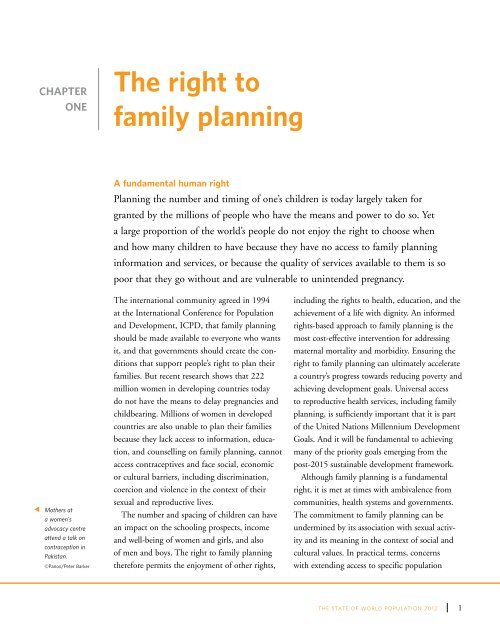State of World Population 2012 - Country Page List - UNFPA
State of World Population 2012 - Country Page List - UNFPA
State of World Population 2012 - Country Page List - UNFPA
You also want an ePaper? Increase the reach of your titles
YUMPU automatically turns print PDFs into web optimized ePapers that Google loves.
CHAPTER<br />
ONE<br />
The right to<br />
family planning<br />
A fundamental human right<br />
Planning the number and timing <strong>of</strong> one’s children is today largely taken for<br />
granted by the millions <strong>of</strong> people who have the means and power to do so. Yet<br />
a large proportion <strong>of</strong> the world’s people do not enjoy the right to choose when<br />
and how many children to have because they have no access to family planning<br />
information and services, or because the quality <strong>of</strong> services available to them is so<br />
poor that they go without and are vulnerable to unintended pregnancy.<br />
t<br />
Mothers at<br />
a women's<br />
advocacy centre<br />
attend a talk on<br />
contraception in<br />
Pakistan.<br />
©Panos/Peter Barker<br />
The international community agreed in 1994<br />
at the International Conference for <strong>Population</strong><br />
and Development, ICPD, that family planning<br />
should be made available to everyone who wants<br />
it, and that governments should create the conditions<br />
that support people’s right to plan their<br />
families. But recent research shows that 222<br />
million women in developing countries today<br />
do not have the means to delay pregnancies and<br />
childbearing. Millions <strong>of</strong> women in developed<br />
countries are also unable to plan their families<br />
because they lack access to information, education,<br />
and counselling on family planning, cannot<br />
access contraceptives and face social, economic<br />
or cultural barriers, including discrimination,<br />
coercion and violence in the context <strong>of</strong> their<br />
sexual and reproductive lives.<br />
The number and spacing <strong>of</strong> children can have<br />
an impact on the schooling prospects, income<br />
and well-being <strong>of</strong> women and girls, and also<br />
<strong>of</strong> men and boys. The right to family planning<br />
therefore permits the enjoyment <strong>of</strong> other rights,<br />
including the rights to health, education, and the<br />
achievement <strong>of</strong> a life with dignity. An informed<br />
rights-based approach to family planning is the<br />
most cost-effective intervention for addressing<br />
maternal mortality and morbidity. Ensuring the<br />
right to family planning can ultimately accelerate<br />
a country’s progress towards reducing poverty and<br />
achieving development goals. Universal access<br />
to reproductive health services, including family<br />
planning, is sufficiently important that it is part<br />
<strong>of</strong> the United Nations Millennium Development<br />
Goals. And it will be fundamental to achieving<br />
many <strong>of</strong> the priority goals emerging from the<br />
post-2015 sustainable development framework.<br />
Although family planning is a fundamental<br />
right, it is met at times with ambivalence from<br />
communities, health systems and governments.<br />
The commitment to family planning can be<br />
undermined by its association with sexual activity<br />
and its meaning in the context <strong>of</strong> social and<br />
cultural values. In practical terms, concerns<br />
with extending access to specific population<br />
THE STATE OF WORLD POPULATION <strong>2012</strong><br />
1
















